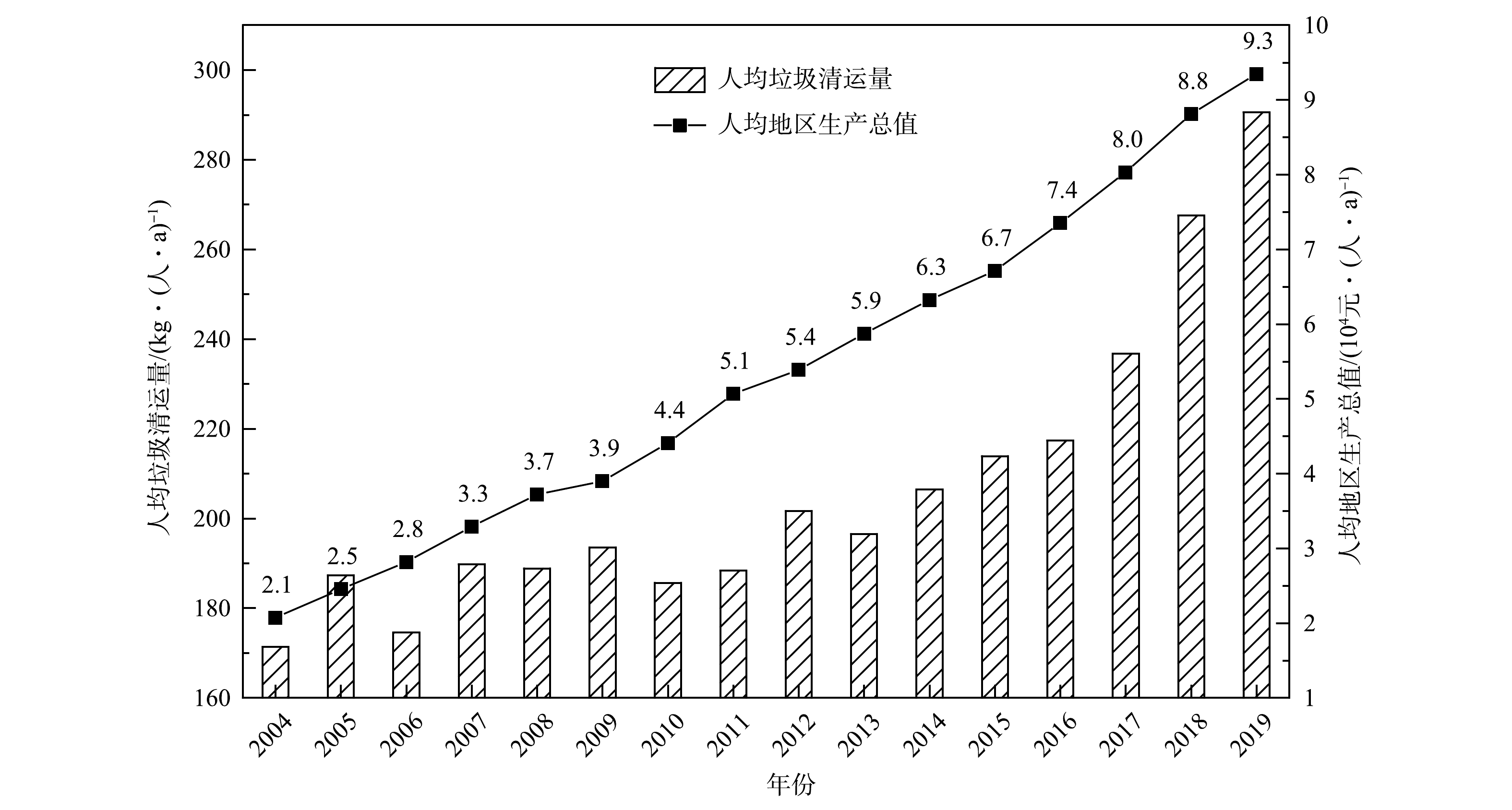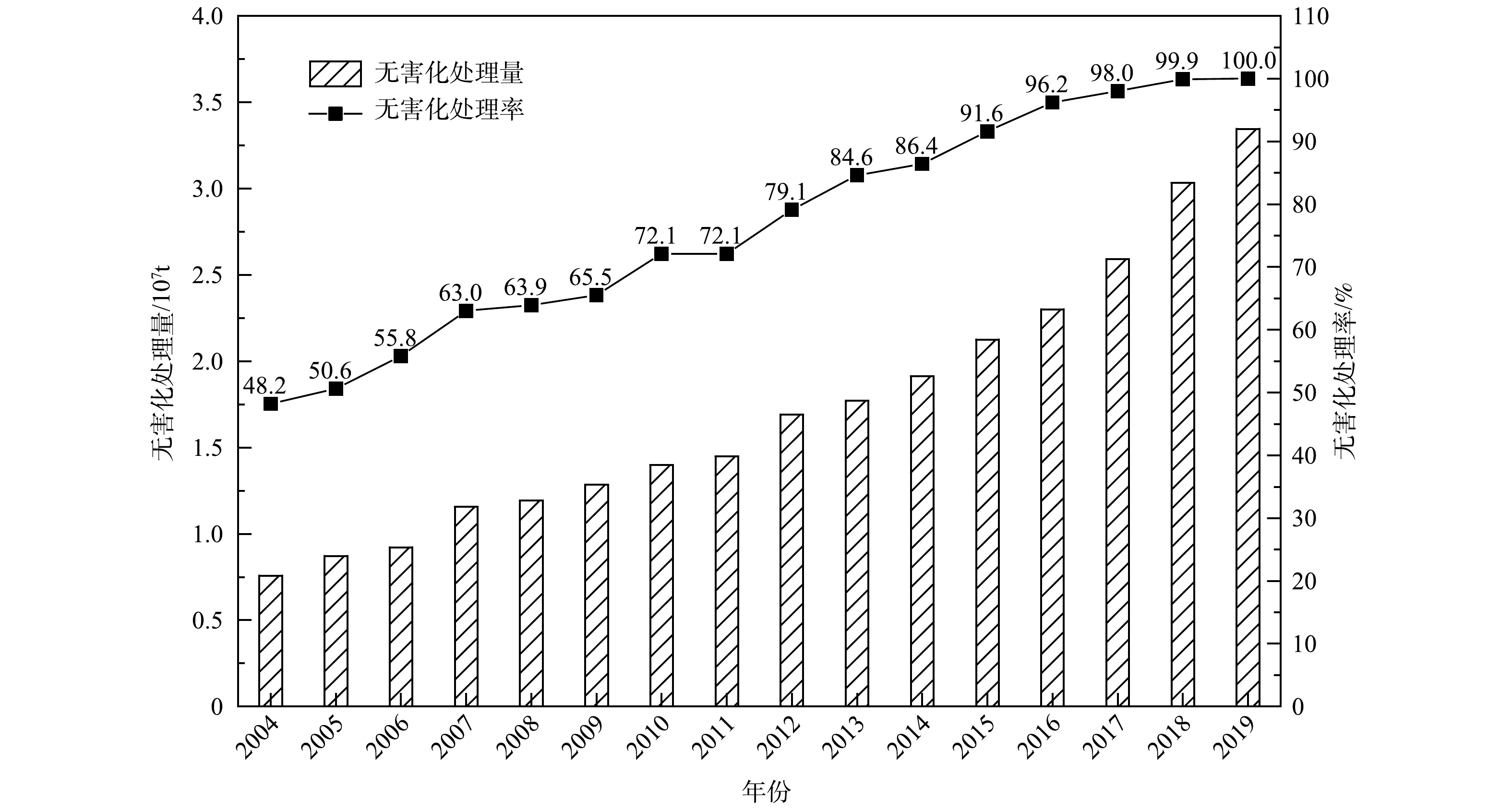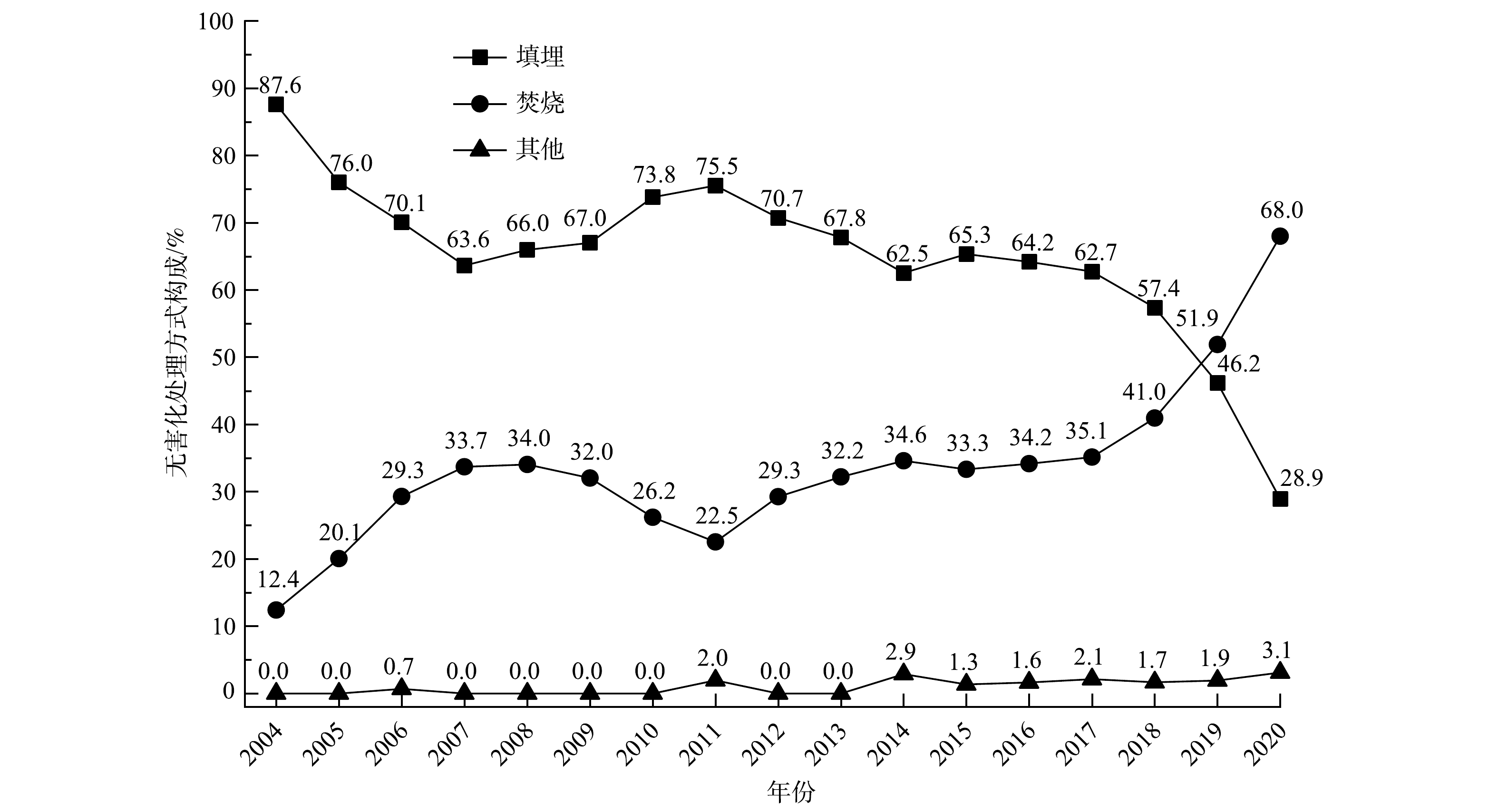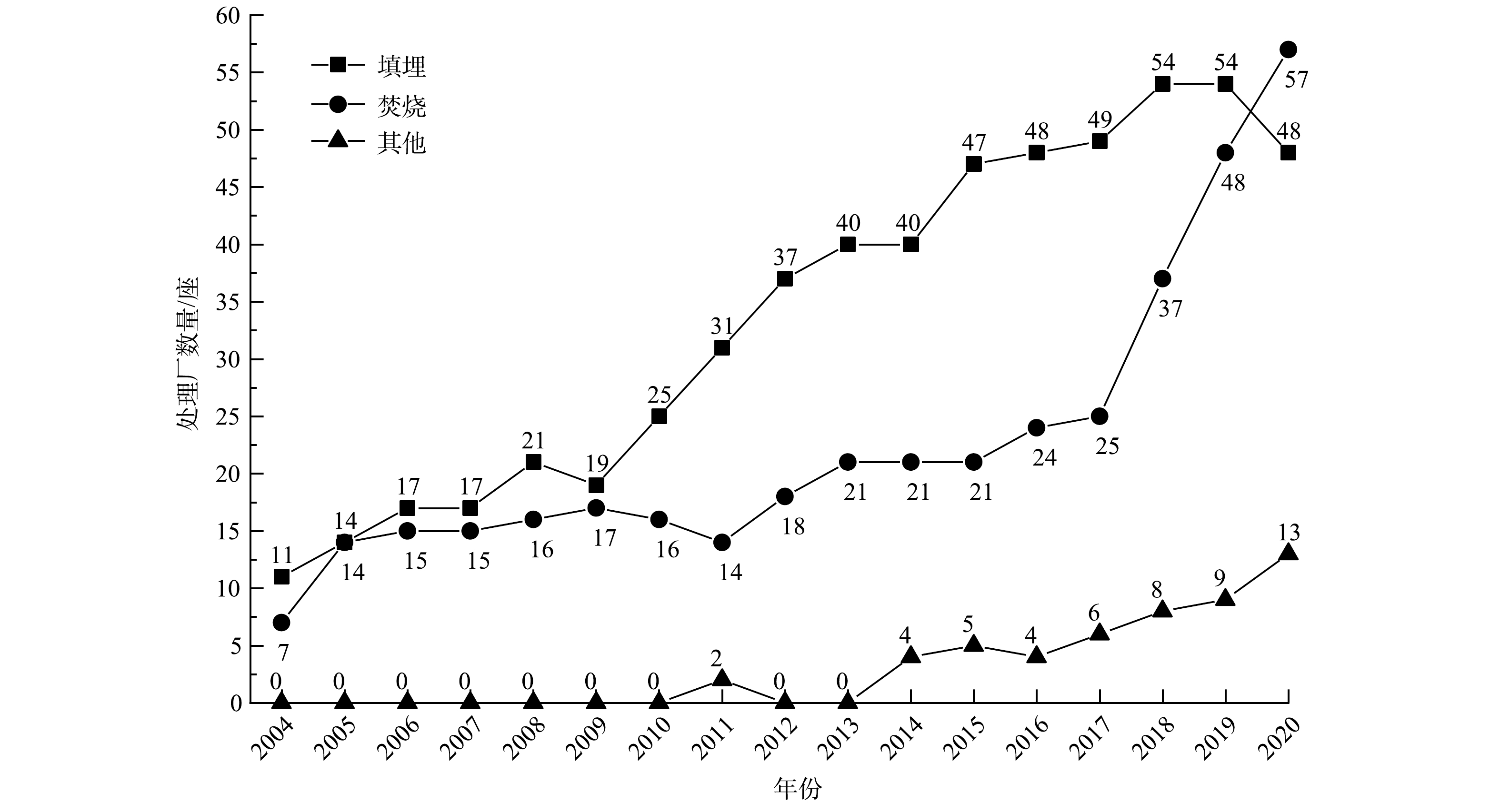-
随着人口增长、经济发展和城市化进程的推进,生活垃圾处理成为环境治理的一个重要问题。其中,我国保持着较高的城市化和国内生产总值增长率。我国当前超过400座城市出现了“垃圾围城”局面,全国垃圾存量占地累计达5×104 hm2,其中,广东、江苏、山东、浙江、福建等省的生活垃圾产生量保持着较高增长趋势[1-2]。
广东省作为全国第一经济大省,自1989年起,国内生产总值持续居全国第一位,经济总量占全国的1/8,已达到中等发达国家水平[3]。随着广东省经济的快速发展,人口的激增,群众生活水平的提高以及生活方式的多样化,其生活垃圾处理问题也逐渐受到关注[4-5]。广东省生活垃圾产生量每年以超过10%的速度增长(生活垃圾产生量是指生活垃圾清运量总和)。据中国统计年鉴[6],2020年,我国生活垃圾清运量达到2.4×108 t,其中广东省生活垃圾清运量达到3.1×107 t,占我国生活垃圾清运量的比例高达13.2%。根据近年生活垃圾清运量变化趋势,结合广东省人口发展趋势和生活垃圾分类工作进程等实际情况,预估2025年全省生活垃圾清运量可达1.6×105 t·d−1[7]。随着垃圾清运量的提高,如何有效处理生活垃圾已成为广东省面临的一个亟待解决的问题[8]。
本研究梳理了广东省2004—2020年生活垃圾产生和处理情况,分析了广东省生活垃圾主要处理方式的变化趋势及原因,提出了实现广东省城市生活垃圾处理可持续发展的建议,以期为广东省有关部门制定垃圾无害化处理政策与规划提供参考。
-
生活垃圾的产生会受到人口和地区生产总值的影响。图1显示了广东省人均生活垃圾清运量与人均地区生产总值之间的关系。从图1可以看出,人均生活垃圾清运量在2014年前后的变化趋势不同。2004—2013年,广东省人均地区生产总值从2.1×104 元·(人·a)−1增至5.9×104 元·(人·a)−1(增长了1.8倍),人均生活垃圾清运量维持在171.4 ~201.7 kg·(人·a)−1,变化不大。2014—2019年,人均地区生产总值从6.4×104 元·(人·a)−1增至9.3×104 元·(人·a)−1(增长了45.3%),人均生活垃圾清运量从206.5 kg·(人·a)−1增至290.5 kg·(人·a)−1(增长了40.7%)。这说明,当人均地区生产总值低于某一个值时,对人均生活垃圾清运量影响不大。
广东省生活垃圾的产生量日益增大,相应地,生活垃圾处理能力也不断提高。如图2所示,2004—2019年,无害化处理量和处理率基本呈同步增加趋势,生活垃圾无害化处理水平逐渐提高。无害化处理量由2004年的7.6×106 t增加到2019年的3.4×107 t,增长4.4倍,年均增长率为10.6%。生活垃圾无害化处理率由2004年的48.2%提高到2019年的100%,已提前完成“十三五”时期城乡生活垃圾处理发展中的目标值,即2020年末,全省城市生活垃圾无害化处理率达到98%以上[11]。
-
目前,生活垃圾的无害化处理方式主要有填埋、焚烧和以堆肥为主的其他方式[12]。广东省生活垃圾无害化处理方式构成如图3所示,其主要处理方式为填埋与焚烧。2004—2020年,填埋无害化处理量占无害化处理量的比例总体上呈波动下降趋势,由87.6%逐步下降到28.9%,降低了58.7%,并在2019年首次低于50%。焚烧无害化处理量占无害化处理量的比例总体上呈波动上升趋势,由12.4%增长到68.0%,增长了55.6%,并在2019年首次超过50%,成为主导处理方式。其中,2010—2011年,焚烧占比有所下降,最低降至22.5%。
2020年广东省拥有无害化处理厂118座,总处理能力达到1.4×105 t·d−1。图4反映了2004—2020年广东省无害化处理厂座数变化情况。2004—2020年,广东省生活垃圾无害化焚烧厂的数量呈波动增加趋势,由7座增加至57座,增长了8.1倍。其中,2010—2011年,焚烧厂数量有所下降,这与图3焚烧量占比下降趋势一致。其主要原因是,焚烧厂部分项目面临改造升级而停产,新增项目的增量不足以抵消技术改造和停产项目的减量[13]。2015年以后,广东省焚烧处理厂座数增长较快,由24座增加至57座,增加了2.4倍。填埋场数量基本呈增加趋势,尤其是2009—2015年,由19座快速增加至47座,增加2.5倍。2016年以后,增加速度放缓,与2018年相比,2020年填埋场的数量减少到48座。以堆肥为主的其他无害化处理厂的数量增加缓慢,至2020年仅为13座,这与浙江、江苏地区的情况相似。浙江有生活垃圾无害化处理厂76座,以堆肥为主的其他无害化处理厂仅有7座,其占生活垃圾无害化处理能力的比例仅为7.6%。江苏有生活垃圾无害化处理厂85座,以堆肥为主的其他无害化处理厂有14座,其占生活垃圾无害化处理能力的比例仅为4.7%。可见,经济发展比较快的省份在堆肥处理设施的投入比例不高。
《广东省城乡生活垃圾处理“十三五”规划》要求,2018年全省城市生活垃圾焚烧处理能力占无害化处理总能力的比例要达到55%以上,2020年达到60%以上[11]。由图5可知,2018年该比例为50%,未达到规划要求;2019年达到55%,比设定目标年限延迟一年。2020年生活垃圾焚烧无害化处理能力占生活垃圾无害化总处理能力的比例为64%,达到了目标要求。尽管广东省垃圾焚烧能力持续增加,但与人口密度相近的发达省份和国家相比仍存在一定差距。比如,2020年江苏和浙江的焚烧无害化处理占比分别达到78.8%和76.5%。日本自1960年开始对生活垃圾进行焚烧处理,2017年焚烧率高达80.3%,成为日本处理垃圾的主要方式[14]。可见,在经济发展较好的省份或国家会更加注重提高生活垃圾焚烧处理能力。
-
由以上分析可以看出,广东省垃圾处理方式已逐步由以填埋为主、焚烧为辅、其他为补充的旧格局,转变为以焚烧为主、填埋为辅、生物处理为补充的新格局[15]。这种新格局的形成与填埋、焚烧和堆肥等方法的优缺点,广东省的自然地理条件以及经济发展水平有一定的关系。
填埋法具有简单易操作、运行成本低的优势,但存在占用大量土地资源、资源化利用率低、封场后维护时间长、产生的垃圾渗滤液和填埋气体难处理等问题[16-19]。蔡博峰等[20]的研究结果表明,广东是人口大省,垃圾填埋量相对较多,恶臭影响的人口数量居各省(自治区、直辖市)第一。陈迪云等[21]的研究表明,广州市的李坑、兴丰2个填埋场周围地表水体和地下水都受到了渗滤液中的PAHs和PAEs的污染,附近居民水井的PAHs的总浓度远高于国际饮用水标准。2019年广东省人口达到1.2×108,约占全国人口的8.2%,而陆地面积约1.8×105 km2,约占全国陆地面积的1.9%,说明广东省人多地少。随着已有填埋场的逐渐封场,适合填埋的场址越来越少。目前,广州市生活垃圾填埋场日均垃圾接收量已接近满负荷。在这种情况下,广州市决定建设7个循环经济产业园,将焚烧、生化、填埋等以组团的形式集中在一起,打破以“填埋”为主的垃圾处理方式,建设以“焚烧为主、生化为辅、循环利用”的新格局,最终实现“垃圾零填埋”[22]。《广东省生活垃圾处理“十四五”规划》中指出[7],各地级以上城市以及具备焚烧处理能力的县(市),原则上不再新建原生生活垃圾填埋场,现有卫生填埋场主要作为垃圾焚烧产物最终处置场所以及垃圾无害化处理应急保障设施使用。广东省推进“无废城市”建设试点工作方案中也提到[23],到2023年底,无废试验区基本实现原生生活垃圾“零填埋”。因此,大规模原生垃圾填埋处理方式已逐渐不适应广东省部分城市的社会与经济发展需求。
堆肥本身是较为成熟的生活垃圾处理技术,但存在处理成本高,堆肥肥效低,无法适应农业的快速发展,特别是存在市场化推进困难等问题[24-25]。自2011年起,中国统计年鉴均未再出现生活垃圾堆肥相关数据,而以“其他”处理方式替代。《广东省生活垃圾处理“十四五”规划》指出[7],对于厨余垃圾资源化产品缺乏消纳途径的地区,厨余垃圾可经预处理后与现有生活垃圾焚烧处理设施协同处理。堆肥处理设施能力不足且具备焚烧处理条件的地区,可经预处理脱水干化后焚烧处理。基于上述原因,堆肥无害化处理方式发展缓慢,有被逐渐摒弃的趋势。在这种形势下,如果要发展堆肥处理方式,则需要解决好堆肥产品在农业、林业生产中应用受阻的问题及相关的产业政策问题。
焚烧法成本高,但因具有耗时短、占地面积小、运营过程中更绿色安全和余热可回收等优点而受到广泛认可。据统计,焚烧法处理可使生活垃圾减容85%以上,减重75%以上,符合减量化、无害化的目标。随着经济的发展,广东省逐渐能够承担焚烧法的高成本。根据图1、图4和图5可知,从2014年开始,广东省垃圾焚烧厂数量和焚烧占比均快速增加,此时广东省的人均地区生产总值达到6.4×104 元·(人·a)−1。与此同时,随着焚烧技术的逐渐成熟,以及给予焚烧发电适当经济补贴等国家政策,都加速了焚烧发电产业的发展[26-30]。从可利用热值角度来看,广东省生活垃圾热值较高,平均入厂生活垃圾热值基本在6 000 kJ·kg−1以上,入炉生活垃圾热值大于7 500 kJ·kg−1[31],高于焚烧最低热值限(3 344 kJ·kg−1)[32]。这些因素都促进了广东省采用焚烧的方式处理生活垃圾。当然,焚烧也存在一些问题,比如炉渣、飞灰的处理与资源化问题,还会产生二噁英和重金属等二次污染物。对此,解决方式也有很多,比如炉渣做建筑材料,飞灰用于生产水泥熟料,这些途径可实现资源化利用[33]。在焚烧前对生活垃圾进行必要的分类、分拣及预处理可有效降低二噁英和重金属的污染[34]。《广东省生活垃圾处理“十四五”规划》[7]中指出,广东省打造“焚烧为主、生化为辅、填埋兜底”的生活垃圾处理格局,到2025年底,焚烧处理能力占比要达到80%以上。因此,广东省将会全面提升生活垃圾焚烧处理能力。
目前我国已经开始实行垃圾分类制度,并于2017年3月发布了《生活垃圾分类制度实施方案》[35],将垃圾分为可回收物、有害垃圾、厨余垃圾和其他垃圾4大类。其中,厨余垃圾来源分散且数量庞大,占垃圾总量的比例超过50%[36-37]。广东省的生活垃圾成分以厨余类垃圾为主,据调查[38-39],广州市厨余垃圾占61%、塑料占17.5%、织物占4.3%、玻璃占3.0%;深圳市厨余垃圾占59.4%、塑料占14%、织物占3.9%、玻璃占5.0%。张海龙等[40]研究广东省中南部某市垃圾组成中发现,厨余类所占比例为39.8%~53.3%,橡塑类占16.5%~33.4%,纺织类占1.1%~5.2%,玻璃类占为1.1%~1.47%。如果分选出来的厨余垃圾仍然采用填埋或焚烧处理,那么垃圾分类就失去了意义[41]。因此,合理选择厨余垃圾的处理方式对于有效实现垃圾“减量化、资源化、无害化”至关重要。
广东省已建成17座大型厨余垃圾专业处理项目和一批小型处理设备,处理能力约5 300 t·d−1[42]。厨余垃圾处理方式主要有厌氧消化、好氧堆肥、饲养微小动物处理、三相分离协同焚烧和卫生填埋[43]。《深圳市生活垃圾分类管理条例》中指出,厨余垃圾应当主要采用产沼、制肥等生化处理方式进行资源化利用[44]。利用厌氧消化产沼气的方式具有碳排放低、二次污染少、运行成本低、适合集中大规模处理等优点[45-46],其减排效应显著,理想情况下厌氧消化碳减排效益是好氧堆肥的22倍[47]。因此,在深圳和其他类似的大城市,常用厌氧消化来处理厨余垃圾[48]。饲养微小动物处理项目主要采用黑水虻处理技术,其项目建设运营成本较低、产品销路好、价值高。惠州惜福厨余垃圾处理项目中的黑水虻每天能“吃掉”100 t左右的厨余垃圾,产出约10 t虫体蛋白和约15 t虫粪,烘干的虫体蛋白和虫粪的售价分别约为6 000 元·t−1和500 元·t−1[43]。因此,在广州、汕头和湛江的黑水虻试点项目不需要财政补贴也能正常运行。广东省推进“无废城市”建设试点工作方案中指出[23],珠三角所有城市推广可回收物利用、焚烧发电、生物处理等资源化利用方式。因此,生物处理法的比例有可能提高,并成为广东省部分城市垃圾处理的一个重要方向。
从“双碳”理念的角度来看,填埋处理的温室气体排放量明显高于焚烧和堆肥等方式。目前广州市温室气体排放增量主要来源于固体废物处理,其中90%以上来源于生活垃圾处理。广州市生活垃圾处理以填埋为主,填埋处理的温室气体排放量占垃圾处理温室气体排放总量的95%左右[49]。与填埋相比,垃圾焚烧可显著减少温室气体的排放量[50]。廖凌娟等[51]通过对比垃圾焚烧发电、填埋、堆肥的碳排放量和减排量得出,填埋碳排放量最大,其次是焚烧和堆肥。而垃圾焚烧发电减排量最高,达38.0%,卫生填埋减排量仅为14.9%。仲璐等[52]对生活垃圾处理的温室气体排放的计算结果显示,填埋、焚烧和堆肥每处理1 t垃圾产生的碳排放分别是1.7、0.5、0.2 t的二氧化碳当量。尽管堆肥的碳排放最低,但堆肥产品的推广应用困难在一定程度上限制了堆肥处理方式的发展。利用垃圾焚烧产生的热能发电,能实现垃圾的资源化,可以在一定程度上减少化石能源的使用,进而减少碳排放,符合“碳中和”发展理念。
-
1)广东省生活垃圾的产生量日益增大,相应地,其无害化处理率不断提高,2019年基本达到100%。
2)广东省垃圾处理方式已逐步由以填埋为主、焚烧为辅、其他为补充的旧格局,转变为以焚烧为主、填埋为辅、生物处理为补充的新格局。2020年焚烧无害化处理能力占无害化总处理能力的比例为64%,达到《广东省城乡生活垃圾处理“十三五”规划》中的目标值(2020年达到60%以上)。
3)广东省要因地制宜选择技术先进、经济适用的垃圾处理技术。填埋方式逐步向焚烧发电等资源化利用程度较高的处理方式发展,有利于实现“双碳”目标。可适度超前建设垃圾焚烧处理设施,提高焚烧能力占比,使有条件的地区率先实现原生生活垃圾“零填埋”。基于垃圾分类以及厨余垃圾占比较大的实际情况,今后生物处理法有可能成为广东省部分城市垃圾处理的一个重要方向。对于厨余垃圾资源化产品缺乏消纳途径的地区,厨余垃圾可经预处理后与现有生活垃圾焚烧处理设施协同处理。
广东省生活垃圾处理方式变化趋势及其原因
Changing trend and its causes of domestic waste treatment methods in Guangdong Province
-
摘要: 针对广东省生活垃圾处理存在的问题,通过收集和整理广东省生活垃圾产生和处理的相关数据及政府统计报告,分析了生活垃圾处理量和处理方式的变化趋势及其原因,并提出了相应建议,以供广东省有关管理部门参考。结果表明,广东省生活垃圾产生量从2004年的1.6×107 t增长至2020年的3.1×107 t,生活垃圾无害化处理率由42.8%提高到100%。广东省生活垃圾处理方式由填埋为主、焚烧为辅、其他补充的旧格局,转变为焚烧为主、填埋为辅、生物处理为补充的新格局。2020年,广东省生活垃圾焚烧处理能力占无害化处理能力的比例为64%,已达到十三五规划中焚烧比例的要求。结合广东省的实际并基于碳中和的目标,广东省可适度超前建设垃圾焚烧处理设施,提高焚烧能力占比,引导有条件的地区率先实现原生生活垃圾“零填埋”。对于厨余垃圾资源化产品缺乏消纳途径的地区,厨余垃圾可经预处理后与现有生活垃圾焚烧处理设施协同处理。本研究结果可为广东省有关部门制定垃圾无害化处理政策与规划提供参考。Abstract: In view of the existing problems of domestic waste treatment in Guangdong Province, through collecting and sorting out the related data and government statistical reports on the generation and treatment of domestic waste in Guangdong Province, this paper analyzed the changing trend and reasons of the amount and treatment method of domestic waste, and put forward corresponding suggestions for the reference of the relevant administrative departments in Guangdong Province. The results showed that the domestic waste generation increased from 16.0 million tons in 2004 to 31.0 million tons in 2020, and the harmless treatment rate increased from 42.8% up to 100%. The treatment mode of domestic waste in Guangdong Province has changed from the old pattern of landfill as the main, incineration as the auxiliary and other supplements to the new pattern of incineration as the main, landfill as the auxiliary and biological treatment as the supplement. In 2020, the incineration and treatment capacity of domestic waste in Guangdong Province accounted for 64% of the harmless treatment capacity, which has reached the requirement of incineration ratio in the 13th Five-Year Plan. Based on the reality of Guangdong Province and the goal of carbon neutrality, Guangdong Province can build waste incineration facilities in advance, increase the proportion of incineration capacity, and guide the regions where conditions permit to take the lead in realizing “zero landfill” of native domestic waste. For the areas where there is no way to consume the food waste resource products, the food waste can be processed together with the existing domestic waste incineration treatment facilities after pretreatment. The results of this study can provide reference for the relevant departments in Guangdong Province to formulate the policy and planning of waste harmless treatment.
-
随着人口增长、经济发展和城市化进程的推进,生活垃圾处理成为环境治理的一个重要问题。其中,我国保持着较高的城市化和国内生产总值增长率。我国当前超过400座城市出现了“垃圾围城”局面,全国垃圾存量占地累计达5×104 hm2,其中,广东、江苏、山东、浙江、福建等省的生活垃圾产生量保持着较高增长趋势[1-2]。
广东省作为全国第一经济大省,自1989年起,国内生产总值持续居全国第一位,经济总量占全国的1/8,已达到中等发达国家水平[3]。随着广东省经济的快速发展,人口的激增,群众生活水平的提高以及生活方式的多样化,其生活垃圾处理问题也逐渐受到关注[4-5]。广东省生活垃圾产生量每年以超过10%的速度增长(生活垃圾产生量是指生活垃圾清运量总和)。据中国统计年鉴[6],2020年,我国生活垃圾清运量达到2.4×108 t,其中广东省生活垃圾清运量达到3.1×107 t,占我国生活垃圾清运量的比例高达13.2%。根据近年生活垃圾清运量变化趋势,结合广东省人口发展趋势和生活垃圾分类工作进程等实际情况,预估2025年全省生活垃圾清运量可达1.6×105 t·d−1[7]。随着垃圾清运量的提高,如何有效处理生活垃圾已成为广东省面临的一个亟待解决的问题[8]。
本研究梳理了广东省2004—2020年生活垃圾产生和处理情况,分析了广东省生活垃圾主要处理方式的变化趋势及原因,提出了实现广东省城市生活垃圾处理可持续发展的建议,以期为广东省有关部门制定垃圾无害化处理政策与规划提供参考。
1. 资料收集与处理
2004—2020年广东省生活垃圾清运量、无害化处理量、无害化处理率、地区生产总值和年末常住人口等数据来源于《中国统计年鉴》及中华人民共和国住房和城乡建设部[9-10]。根据相关数据或资料,分析广东省无害化处理量和无害化处理率的变化、人均生活垃圾清运量与人均地区生产总值的关系、生活垃圾无害化处理方式构成、无害化处理厂座数变化及无害化处理能力的变化。
2. 结果与讨论
2.1 广东省生活垃圾产生与处理现状
生活垃圾的产生会受到人口和地区生产总值的影响。图1显示了广东省人均生活垃圾清运量与人均地区生产总值之间的关系。从图1可以看出,人均生活垃圾清运量在2014年前后的变化趋势不同。2004—2013年,广东省人均地区生产总值从2.1×104 元·(人·a)−1增至5.9×104 元·(人·a)−1(增长了1.8倍),人均生活垃圾清运量维持在171.4 ~201.7 kg·(人·a)−1,变化不大。2014—2019年,人均地区生产总值从6.4×104 元·(人·a)−1增至9.3×104 元·(人·a)−1(增长了45.3%),人均生活垃圾清运量从206.5 kg·(人·a)−1增至290.5 kg·(人·a)−1(增长了40.7%)。这说明,当人均地区生产总值低于某一个值时,对人均生活垃圾清运量影响不大。
广东省生活垃圾的产生量日益增大,相应地,生活垃圾处理能力也不断提高。如图2所示,2004—2019年,无害化处理量和处理率基本呈同步增加趋势,生活垃圾无害化处理水平逐渐提高。无害化处理量由2004年的7.6×106 t增加到2019年的3.4×107 t,增长4.4倍,年均增长率为10.6%。生活垃圾无害化处理率由2004年的48.2%提高到2019年的100%,已提前完成“十三五”时期城乡生活垃圾处理发展中的目标值,即2020年末,全省城市生活垃圾无害化处理率达到98%以上[11]。
2.2 广东省生活垃圾处理方式的变化
目前,生活垃圾的无害化处理方式主要有填埋、焚烧和以堆肥为主的其他方式[12]。广东省生活垃圾无害化处理方式构成如图3所示,其主要处理方式为填埋与焚烧。2004—2020年,填埋无害化处理量占无害化处理量的比例总体上呈波动下降趋势,由87.6%逐步下降到28.9%,降低了58.7%,并在2019年首次低于50%。焚烧无害化处理量占无害化处理量的比例总体上呈波动上升趋势,由12.4%增长到68.0%,增长了55.6%,并在2019年首次超过50%,成为主导处理方式。其中,2010—2011年,焚烧占比有所下降,最低降至22.5%。
2020年广东省拥有无害化处理厂118座,总处理能力达到1.4×105 t·d−1。图4反映了2004—2020年广东省无害化处理厂座数变化情况。2004—2020年,广东省生活垃圾无害化焚烧厂的数量呈波动增加趋势,由7座增加至57座,增长了8.1倍。其中,2010—2011年,焚烧厂数量有所下降,这与图3焚烧量占比下降趋势一致。其主要原因是,焚烧厂部分项目面临改造升级而停产,新增项目的增量不足以抵消技术改造和停产项目的减量[13]。2015年以后,广东省焚烧处理厂座数增长较快,由24座增加至57座,增加了2.4倍。填埋场数量基本呈增加趋势,尤其是2009—2015年,由19座快速增加至47座,增加2.5倍。2016年以后,增加速度放缓,与2018年相比,2020年填埋场的数量减少到48座。以堆肥为主的其他无害化处理厂的数量增加缓慢,至2020年仅为13座,这与浙江、江苏地区的情况相似。浙江有生活垃圾无害化处理厂76座,以堆肥为主的其他无害化处理厂仅有7座,其占生活垃圾无害化处理能力的比例仅为7.6%。江苏有生活垃圾无害化处理厂85座,以堆肥为主的其他无害化处理厂有14座,其占生活垃圾无害化处理能力的比例仅为4.7%。可见,经济发展比较快的省份在堆肥处理设施的投入比例不高。
《广东省城乡生活垃圾处理“十三五”规划》要求,2018年全省城市生活垃圾焚烧处理能力占无害化处理总能力的比例要达到55%以上,2020年达到60%以上[11]。由图5可知,2018年该比例为50%,未达到规划要求;2019年达到55%,比设定目标年限延迟一年。2020年生活垃圾焚烧无害化处理能力占生活垃圾无害化总处理能力的比例为64%,达到了目标要求。尽管广东省垃圾焚烧能力持续增加,但与人口密度相近的发达省份和国家相比仍存在一定差距。比如,2020年江苏和浙江的焚烧无害化处理占比分别达到78.8%和76.5%。日本自1960年开始对生活垃圾进行焚烧处理,2017年焚烧率高达80.3%,成为日本处理垃圾的主要方式[14]。可见,在经济发展较好的省份或国家会更加注重提高生活垃圾焚烧处理能力。
2.3 广东省生活垃圾处理方式变化的原因及处理建议
由以上分析可以看出,广东省垃圾处理方式已逐步由以填埋为主、焚烧为辅、其他为补充的旧格局,转变为以焚烧为主、填埋为辅、生物处理为补充的新格局[15]。这种新格局的形成与填埋、焚烧和堆肥等方法的优缺点,广东省的自然地理条件以及经济发展水平有一定的关系。
填埋法具有简单易操作、运行成本低的优势,但存在占用大量土地资源、资源化利用率低、封场后维护时间长、产生的垃圾渗滤液和填埋气体难处理等问题[16-19]。蔡博峰等[20]的研究结果表明,广东是人口大省,垃圾填埋量相对较多,恶臭影响的人口数量居各省(自治区、直辖市)第一。陈迪云等[21]的研究表明,广州市的李坑、兴丰2个填埋场周围地表水体和地下水都受到了渗滤液中的PAHs和PAEs的污染,附近居民水井的PAHs的总浓度远高于国际饮用水标准。2019年广东省人口达到1.2×108,约占全国人口的8.2%,而陆地面积约1.8×105 km2,约占全国陆地面积的1.9%,说明广东省人多地少。随着已有填埋场的逐渐封场,适合填埋的场址越来越少。目前,广州市生活垃圾填埋场日均垃圾接收量已接近满负荷。在这种情况下,广州市决定建设7个循环经济产业园,将焚烧、生化、填埋等以组团的形式集中在一起,打破以“填埋”为主的垃圾处理方式,建设以“焚烧为主、生化为辅、循环利用”的新格局,最终实现“垃圾零填埋”[22]。《广东省生活垃圾处理“十四五”规划》中指出[7],各地级以上城市以及具备焚烧处理能力的县(市),原则上不再新建原生生活垃圾填埋场,现有卫生填埋场主要作为垃圾焚烧产物最终处置场所以及垃圾无害化处理应急保障设施使用。广东省推进“无废城市”建设试点工作方案中也提到[23],到2023年底,无废试验区基本实现原生生活垃圾“零填埋”。因此,大规模原生垃圾填埋处理方式已逐渐不适应广东省部分城市的社会与经济发展需求。
堆肥本身是较为成熟的生活垃圾处理技术,但存在处理成本高,堆肥肥效低,无法适应农业的快速发展,特别是存在市场化推进困难等问题[24-25]。自2011年起,中国统计年鉴均未再出现生活垃圾堆肥相关数据,而以“其他”处理方式替代。《广东省生活垃圾处理“十四五”规划》指出[7],对于厨余垃圾资源化产品缺乏消纳途径的地区,厨余垃圾可经预处理后与现有生活垃圾焚烧处理设施协同处理。堆肥处理设施能力不足且具备焚烧处理条件的地区,可经预处理脱水干化后焚烧处理。基于上述原因,堆肥无害化处理方式发展缓慢,有被逐渐摒弃的趋势。在这种形势下,如果要发展堆肥处理方式,则需要解决好堆肥产品在农业、林业生产中应用受阻的问题及相关的产业政策问题。
焚烧法成本高,但因具有耗时短、占地面积小、运营过程中更绿色安全和余热可回收等优点而受到广泛认可。据统计,焚烧法处理可使生活垃圾减容85%以上,减重75%以上,符合减量化、无害化的目标。随着经济的发展,广东省逐渐能够承担焚烧法的高成本。根据图1、图4和图5可知,从2014年开始,广东省垃圾焚烧厂数量和焚烧占比均快速增加,此时广东省的人均地区生产总值达到6.4×104 元·(人·a)−1。与此同时,随着焚烧技术的逐渐成熟,以及给予焚烧发电适当经济补贴等国家政策,都加速了焚烧发电产业的发展[26-30]。从可利用热值角度来看,广东省生活垃圾热值较高,平均入厂生活垃圾热值基本在6 000 kJ·kg−1以上,入炉生活垃圾热值大于7 500 kJ·kg−1[31],高于焚烧最低热值限(3 344 kJ·kg−1)[32]。这些因素都促进了广东省采用焚烧的方式处理生活垃圾。当然,焚烧也存在一些问题,比如炉渣、飞灰的处理与资源化问题,还会产生二噁英和重金属等二次污染物。对此,解决方式也有很多,比如炉渣做建筑材料,飞灰用于生产水泥熟料,这些途径可实现资源化利用[33]。在焚烧前对生活垃圾进行必要的分类、分拣及预处理可有效降低二噁英和重金属的污染[34]。《广东省生活垃圾处理“十四五”规划》[7]中指出,广东省打造“焚烧为主、生化为辅、填埋兜底”的生活垃圾处理格局,到2025年底,焚烧处理能力占比要达到80%以上。因此,广东省将会全面提升生活垃圾焚烧处理能力。
目前我国已经开始实行垃圾分类制度,并于2017年3月发布了《生活垃圾分类制度实施方案》[35],将垃圾分为可回收物、有害垃圾、厨余垃圾和其他垃圾4大类。其中,厨余垃圾来源分散且数量庞大,占垃圾总量的比例超过50%[36-37]。广东省的生活垃圾成分以厨余类垃圾为主,据调查[38-39],广州市厨余垃圾占61%、塑料占17.5%、织物占4.3%、玻璃占3.0%;深圳市厨余垃圾占59.4%、塑料占14%、织物占3.9%、玻璃占5.0%。张海龙等[40]研究广东省中南部某市垃圾组成中发现,厨余类所占比例为39.8%~53.3%,橡塑类占16.5%~33.4%,纺织类占1.1%~5.2%,玻璃类占为1.1%~1.47%。如果分选出来的厨余垃圾仍然采用填埋或焚烧处理,那么垃圾分类就失去了意义[41]。因此,合理选择厨余垃圾的处理方式对于有效实现垃圾“减量化、资源化、无害化”至关重要。
广东省已建成17座大型厨余垃圾专业处理项目和一批小型处理设备,处理能力约5 300 t·d−1[42]。厨余垃圾处理方式主要有厌氧消化、好氧堆肥、饲养微小动物处理、三相分离协同焚烧和卫生填埋[43]。《深圳市生活垃圾分类管理条例》中指出,厨余垃圾应当主要采用产沼、制肥等生化处理方式进行资源化利用[44]。利用厌氧消化产沼气的方式具有碳排放低、二次污染少、运行成本低、适合集中大规模处理等优点[45-46],其减排效应显著,理想情况下厌氧消化碳减排效益是好氧堆肥的22倍[47]。因此,在深圳和其他类似的大城市,常用厌氧消化来处理厨余垃圾[48]。饲养微小动物处理项目主要采用黑水虻处理技术,其项目建设运营成本较低、产品销路好、价值高。惠州惜福厨余垃圾处理项目中的黑水虻每天能“吃掉”100 t左右的厨余垃圾,产出约10 t虫体蛋白和约15 t虫粪,烘干的虫体蛋白和虫粪的售价分别约为6 000 元·t−1和500 元·t−1[43]。因此,在广州、汕头和湛江的黑水虻试点项目不需要财政补贴也能正常运行。广东省推进“无废城市”建设试点工作方案中指出[23],珠三角所有城市推广可回收物利用、焚烧发电、生物处理等资源化利用方式。因此,生物处理法的比例有可能提高,并成为广东省部分城市垃圾处理的一个重要方向。
从“双碳”理念的角度来看,填埋处理的温室气体排放量明显高于焚烧和堆肥等方式。目前广州市温室气体排放增量主要来源于固体废物处理,其中90%以上来源于生活垃圾处理。广州市生活垃圾处理以填埋为主,填埋处理的温室气体排放量占垃圾处理温室气体排放总量的95%左右[49]。与填埋相比,垃圾焚烧可显著减少温室气体的排放量[50]。廖凌娟等[51]通过对比垃圾焚烧发电、填埋、堆肥的碳排放量和减排量得出,填埋碳排放量最大,其次是焚烧和堆肥。而垃圾焚烧发电减排量最高,达38.0%,卫生填埋减排量仅为14.9%。仲璐等[52]对生活垃圾处理的温室气体排放的计算结果显示,填埋、焚烧和堆肥每处理1 t垃圾产生的碳排放分别是1.7、0.5、0.2 t的二氧化碳当量。尽管堆肥的碳排放最低,但堆肥产品的推广应用困难在一定程度上限制了堆肥处理方式的发展。利用垃圾焚烧产生的热能发电,能实现垃圾的资源化,可以在一定程度上减少化石能源的使用,进而减少碳排放,符合“碳中和”发展理念。
3. 结语
1)广东省生活垃圾的产生量日益增大,相应地,其无害化处理率不断提高,2019年基本达到100%。
2)广东省垃圾处理方式已逐步由以填埋为主、焚烧为辅、其他为补充的旧格局,转变为以焚烧为主、填埋为辅、生物处理为补充的新格局。2020年焚烧无害化处理能力占无害化总处理能力的比例为64%,达到《广东省城乡生活垃圾处理“十三五”规划》中的目标值(2020年达到60%以上)。
3)广东省要因地制宜选择技术先进、经济适用的垃圾处理技术。填埋方式逐步向焚烧发电等资源化利用程度较高的处理方式发展,有利于实现“双碳”目标。可适度超前建设垃圾焚烧处理设施,提高焚烧能力占比,使有条件的地区率先实现原生生活垃圾“零填埋”。基于垃圾分类以及厨余垃圾占比较大的实际情况,今后生物处理法有可能成为广东省部分城市垃圾处理的一个重要方向。对于厨余垃圾资源化产品缺乏消纳途径的地区,厨余垃圾可经预处理后与现有生活垃圾焚烧处理设施协同处理。
-
-
[1] DING Y, ZHAO J, LIU J W, et al. A review of China's municipal solid waste (MSW) and comparison with international regions: Management and technologies in treatment and resource utilization[J]. Journal of Cleaner Production, 2021, 293(10): 126144. [2] TAN W B, XI B B, ZHAO X Y, et al. Emerging views on the overall process treatment of municipal domestic waste for the sustainable use of landfills in China[J]. Engineering, 2020, 6(7): 733-735. doi: 10.1016/j.eng.2020.06.003 [3] 广东经济学会课题组, 赵祥, 杜展全. 2021年广东省宏观经济: 走势、问题与对策建议:基于百名经济学者问卷调查的分析[J]. 南方经济, 2021(3): 125-132. [4] 马占云, 姜昱聪, 任佳雪, 等. 生活垃圾无害化处理大气污染物排放清单[J]. 环境科学, 2021, 42(3): 1333-1342. [5] 聂二旗, 郑国砥, 高定, 等. 中国西部农村生活垃圾处理现状及对策分析[J]. 生态与农村环境学报, 2017, 33(10): 882-889. doi: 10.11934/j.issn.1673-4831.2017.10.003 [6] 中华人民共和国国家统计局. 中国统计年鉴[M]. 北京: 中国统计出版社, 2021. [7] 广东省住房和城乡建设厅关于《广东省生活垃圾处理“十四五”规划》的公示[EB/OL]. (2021-07-05) [2021-07-10]. http://zfcxjst.gd.gov.cn/gkmlpt/content/3/3338/post_3338540.html#3846. [8] 孙晓杰, 王春莲, 李倩, 等. 中国生活垃圾分类政策制度的发展演变历程[J]. 环境工程, 2020, 38(8): 65-70. [9] 中华人民共和国国家统计局. 中国统计年鉴[M]. 北京: 中国统计出版社, 2005-2021. [10] 中华人民共和国住房和城乡建设部. 建设统计年鉴[EB/OL]. [2021-10-12]. http://www.mohurd.gov.cn/xytj/tjzljsxytjgb/jstjnj/. [11] 广东省住房和城乡建设厅. 广东省发展和改革委员会关于印发《广东省城乡生活垃圾处理“十三五”规划》的通知[EB/OL]. (2017-04-17)[2021-07-01]. http://zfcxjst.gd.gov.cn/cxjs/zcwj/content/post_13 92454.html. [12] 刘建伟, 赵高辉. 城市生活垃圾资源化综合处理技术研究和应用进展[J]. 科学技术与工程, 2019, 19(34): 40-47. doi: 10.3969/j.issn.1671-1815.2019.34.006 [13] 伍琳瑛. 广东省生活垃圾焚烧处理的现状与发展趋势研究[J]. 环境卫生工程, 2015, 23(3): 33-36. doi: 10.3969/j.issn.1005-8206.2015.03.010 [14] 程伟, 鞠阿莲. 日本生活垃圾焚烧处理现状及启示[J]. 环境卫生工程, 2019, 27(6): 57-60. doi: 10.3969/j.issn.1005-8206.2019.06.012 [15] 魏潇潇, 王小铭, 李蕾, 等. 1979-2016年中国城市生活垃圾产生和处理时空特征[J]. 中国环境科学, 2018, 38(10): 3833-3843. doi: 10.3969/j.issn.1000-6923.2018.10.030 [16] 柯瀚, 徐兴, 胡杰, 等. 垃圾填埋场生化降解指标测试及液气产量评估[J]. 中国环境科学, 2021, 41(9): 4167-4175. [17] 冯晓星. 科学处理缓解“垃圾围城”困局:我国城市垃圾处理问题及对策分析[J]. 环境保护, 2013, 41(15): 41-42. [18] 白秀佳, 张红玉, 顾军, 等. 填埋场陈腐垃圾理化特性与资源化利用研究[J]. 环境工程, 2021, 39(2): 116-120. [19] 李睿, 刘建国, 薛玉伟, 等. 生活垃圾填埋过程含水率变化研究[J]. 环境科学, 2013, 34(2): 804-809. [20] 蔡博峰, 王金南, 龙瀛, 等. 中国垃圾填埋场恶臭影响人口和人群活动研究[J]. 环境工程, 2016, 34(2): 5-9. [21] 陈迪云, 龚剑, 褚红榜. 广州垃圾填埋场周围水体中PAHs和PAEs的污染特征[J]. 广州大学学报(自然科学版), 2016, 15(4): 67-72. [22] 中国建设新闻网. 广州着力破解“垃圾围城”, 致力实现生活垃圾“零填埋”[EB/OL].(2021-09-27)[2021-10-12]. http://www.chinajsb.cn/html/202109/27/23284.html. [23] 广东省人民政府门户网站. 广东省人民政府办公厅关于印发广东省推进“无废城市”建设试点工作方案的通知 [EB/OL]. (2021-03-07)[2021-07-10]. http://www.gd.gov.cn/xxts/content/post_3236547.html. [24] 卜永广, 范荣桂, 禄润卿, 等. 我国城市生活垃圾处理与处置现状分析[J]. 环境与可持续发展, 2017, 42(5): 95-98. doi: 10.3969/j.issn.1673-288X.2017.05.030 [25] 蒋建国, 耿树标, 罗维, 等. 2020年中国垃圾分类背景下厨余垃圾处理热点回眸[J]. 科技导报, 2021, 39(1): 261-276. doi: 10.3981/j.issn.1000-7857.2021.01.022 [26] LIU Y J, CHEN S Q, CHEN A Y, et al. Variations of GHG emission patterns from waste disposal processes in megacity Shanghai from 2005 to 2015[J]. Journal of Cleaner Production, 2021, 295(3): 126338. [27] 李扬, 李金惠, 谭全银, 等. 我国城市生活垃圾处理行业发展与驱动力分析[J]. 中国环境科学, 2018, 38(11): 4173-4179. doi: 10.3969/j.issn.1000-6923.2018.11.024 [28] 任中山, 陈瑛, 王永明, 等. 生活垃圾分类对垃圾焚烧发电产业发展影响的分析[J]. 环境工程, 2021, 39(6): 150-153. [29] 王临清, 李枭鸣, 朱法华. 中国城市生活垃圾处理现状及发展建议[J]. 环境污染与防治, 2015, 37(2): 106-109. [30] 张英民, 尚晓博, 李开明, 等. 城市生活垃圾处理技术现状与管理对策[J]. 生态环境学报, 2011, 20(2): 389-396. doi: 10.3969/j.issn.1674-5906.2011.02.032 [31] 王延涛, 曹阳. 我国城市生活垃圾焚烧发电厂垃圾热值分析[J]. 环境卫生工程, 2019, 27(5): 41-44. [32] 李晓东, 陆胜勇, 徐旭, 等. 中国部分城市生活垃圾热值的分析[J]. 中国环境科学, 2001, 21(2): 156-160. [33] 马懿, 郑仁栋, 周志昊, 等. 生活垃圾焚烧飞灰处置技术与应用瓶颈[J/OL]. 环境工程, 1-11(2021-10-15) [2021-10-20]. http://kns.cnki.net/kcms/detail/11.2097.X.20211014.1802.008.html. [34] 陈怀俊, 牛芳, 王乃继. 垃圾焚烧处置中二噁英和重金属污染的控制技术[J/OL]. 洁净煤技术: 1-34(2020-12-16)[2021-07-10]. http://kns.cnki.net/kcms/detail/11.3676.TD.20201216.1534.002.html. [35] 国家生活垃圾分类制度实施方案(国办发〔2017〕26号)[EB/OL]. (2017-03-18)[2021-07-01]. http://www.huangdao.gov.cn/n10/n27/n98/n110/n308/200227144918874727.html. [36] 邓俊. 餐厨垃圾无害化处理与资源化利用现状及发展趋势[J]. 环境工程技术学报, 2019, 9(6): 637-642. doi: 10.12153/j.issn.1674-991X.2019.05.300 [37] 王凯军, 王婧瑶, 左剑恶, 等. 我国餐厨垃圾厌氧处理技术现状分析及建议[J]. 环境工程学报, 2020, 14(7): 1735-1742. doi: 10.12030/j.cjee.201911085 [38] 李志. 上海市餐厨垃圾管理现状及对策研究[D]. 上海: 上海交通大学, 2009. [39] 董越勇, 邹道安, 刘银秀, 等. 我国城市生活垃圾特点及其处理技术浅析:以杭州市为例[J]. 浙江农业学报, 2016, 28(6): 1055-1060. [40] 张海龙, 李祥平, 齐剑英, 等. 华南某市生活垃圾组成特征分析[J]. 环境科学, 2015, 36(1): 325-332. [41] 赵佳奇, 范晓丹, 邱春生, 等. 厨余垃圾厌氧消化处理难点及调控策略分析[J]. 环境工程, 2020, 38(12): 143-148. [42] 全省城市生活垃圾无害化处理率达99.87% 将强化垃圾分类全链条监管 广东省人民政府门户网站[EB/OL]. (2019-12-12)[2021-07-01]. http://www.gd.gov.cn/gdywdt/bmdt/content/post_2716179.html. [43] 粟颖. 广东省厨余垃圾处理技术现状分析与建议[J]. 再生资源与循环经济, 2020, 13(11): 13-16. doi: 10.3969/j.issn.1674-0912.2020.11.005 [44] 深圳市生活垃圾分类管理条例政策法规[EB/OL]. (2020-07-17)[2021-07-01]. http://cgj.sz.gov.cn/ydmh/zcg/content/post_7900073.html. [45] JIN C X, SUN S Q, YANG D H, et al. Anaerobic digestion: An alternative resource treatment option for food waste in China[J]. Science of the Total Environment, 2021, 779: 146397. doi: 10.1016/j.scitotenv.2021.146397 [46] SAHA S, LEE H. High-rate carboxylate production in dry fermentation of food waste at room temperature[J]. Science of the Total Environment, 2020, 714: 136695. doi: 10.1016/j.scitotenv.2020.136695 [47] 边潇, 宫徽, 阎中, 等. 餐厨垃圾不同“收集-处理”模式的碳排放估算对比[J]. 环境工程学报, 2019, 13(2): 449-456. doi: 10.12030/j.cjee.201808009 [48] YU Q Q, LI H. Moderate separation of household kitchen waste towards global optimization of municipal solid waste management[J]. Journal of Cleaner Production, 2020, 277: 123330. doi: 10.1016/j.jclepro.2020.123330 [49] 谢鹏程, 王文军, 王文秀, 等. 广州市生活垃圾处理的温室气体排放现状与预测[J]. 科技管理研究, 2020, 40(14): 247-252. doi: 10.3969/j.issn.1000-7695.2020.14.030 [50] WANG K H, NAKAKUBO T. Comparative assessment of waste disposal systems and technologies with regard to greenhouse gas emissions: A case study of municipal solid waste treatment options in China[J]. Journal of Cleaner Production, 2020, 260: 120827. doi: 10.1016/j.jclepro.2020.120827 [51] 廖凌娟, 黄娜, 江洪明, 等. 城市生活固体废弃物不同处理方式下的碳排放分析:以东莞市某垃圾焚烧发电厂为例[J]. 安徽农业科学, 2013, 41(16): 7287-7289. doi: 10.3969/j.issn.0517-6611.2013.16.093 [52] 仲璐, 胡洋, 王璐. 城市生活垃圾的温室气体排放计算及减排思考[J]. 环境卫生工程, 2019, 27(5): 45-48. -





 下载:
下载:





